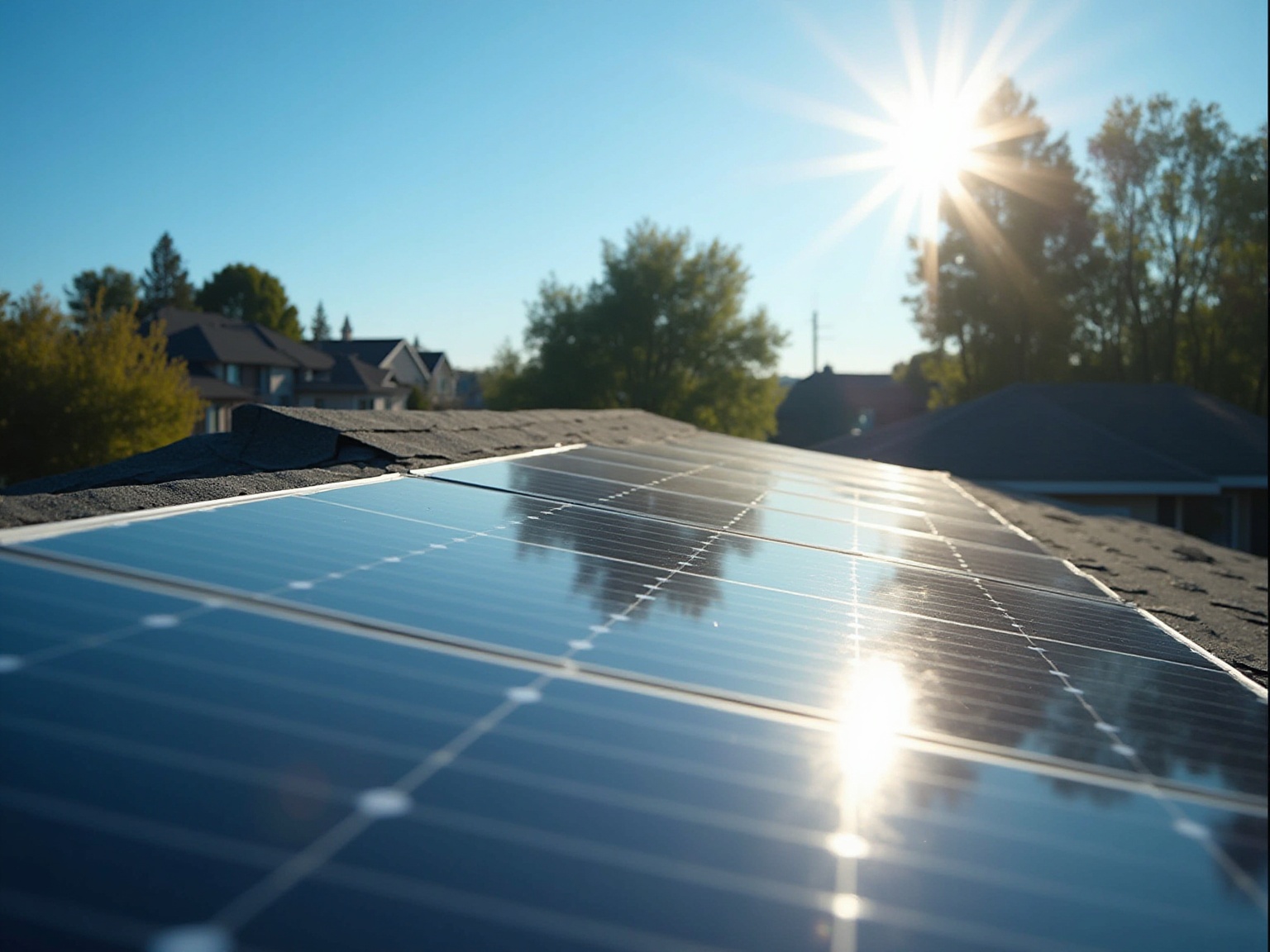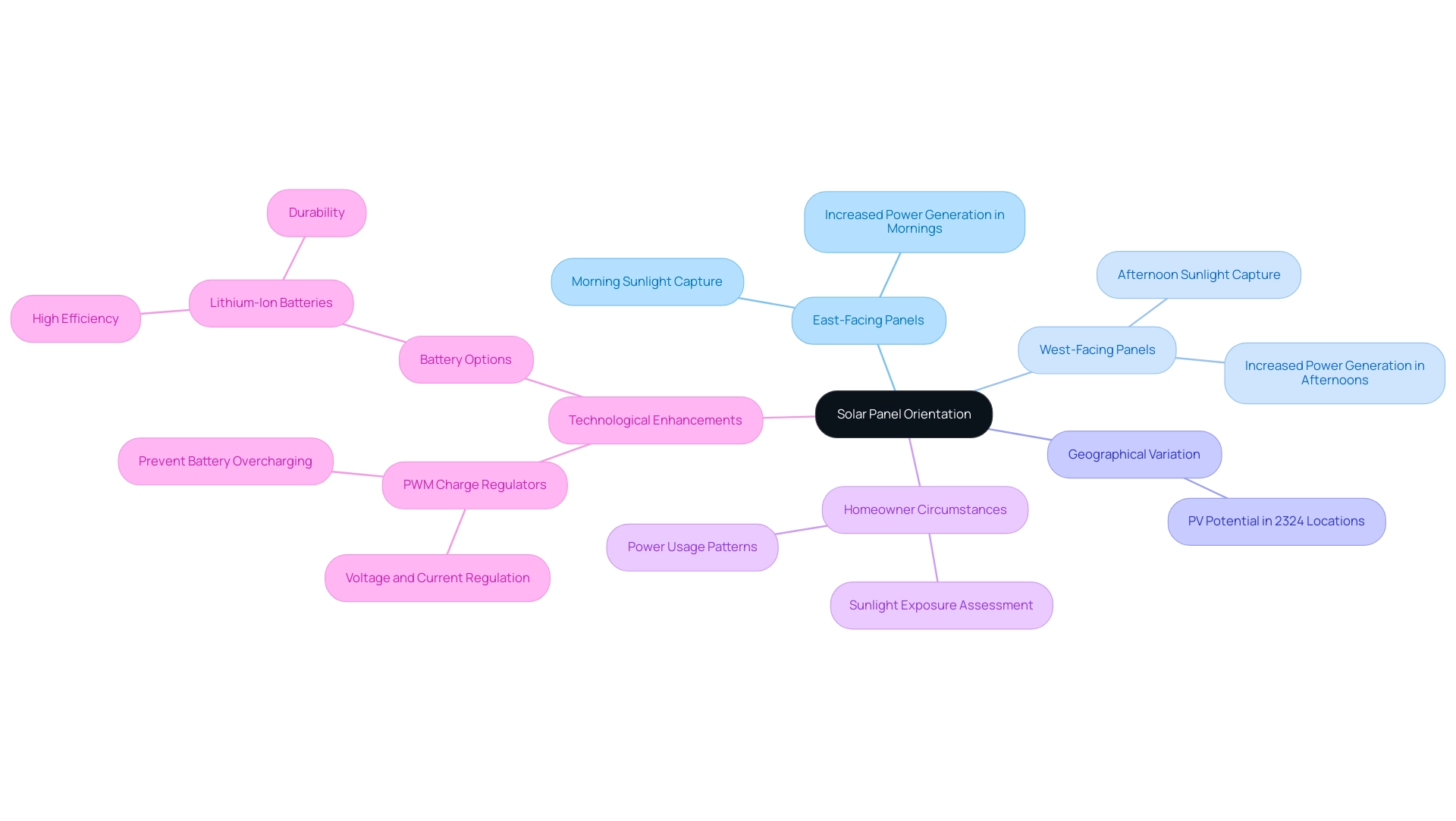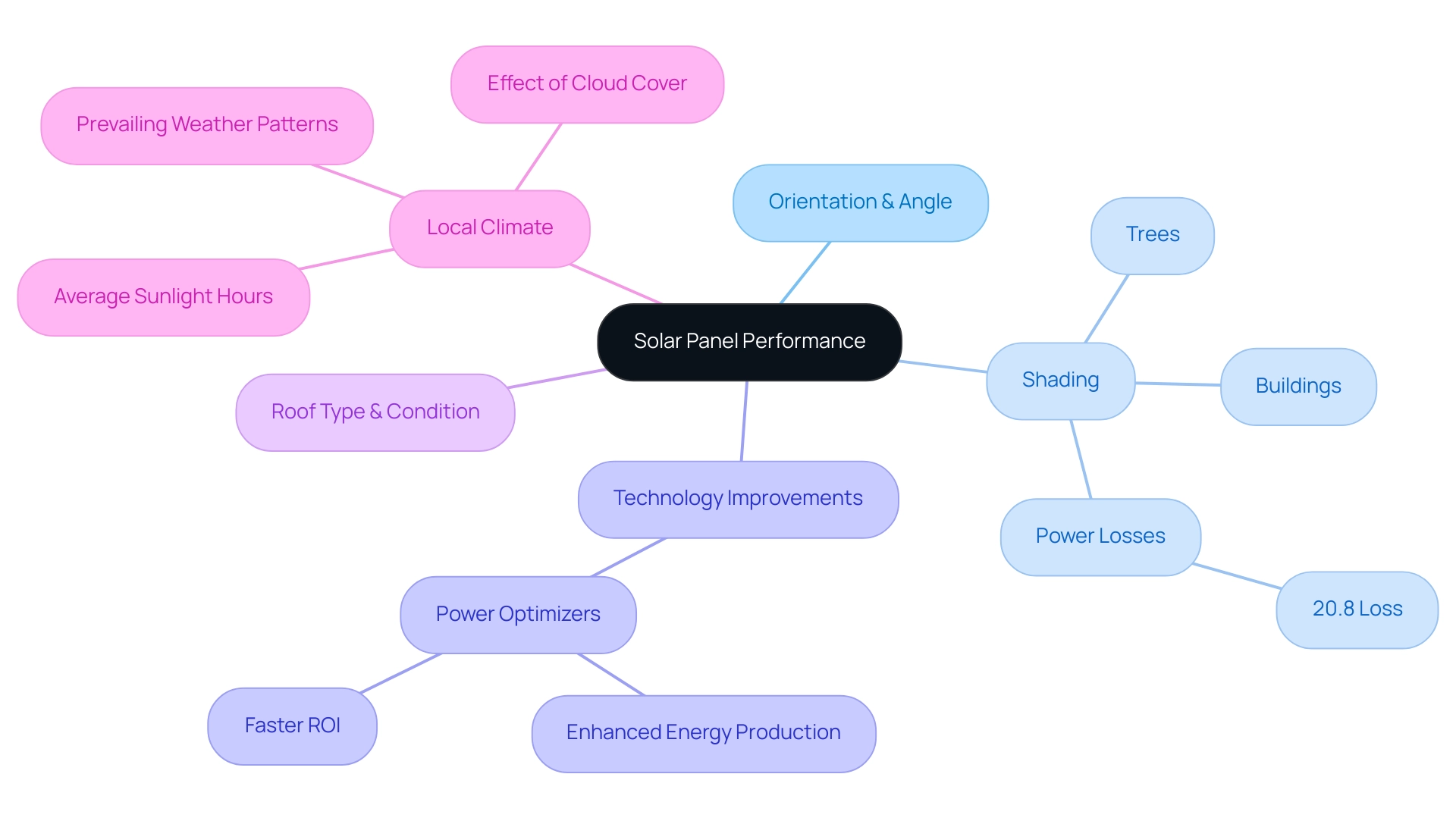Overview
The optimal direction for solar panels to face is typically south in the Northern Hemisphere, as this orientation maximizes sunlight exposure and energy production throughout the day. The article supports this by providing data indicating that south-facing installations can generate up to 20% more energy compared to other orientations, highlighting the importance of strategic placement for maximizing efficiency and cost savings.
Introduction
As homeowners increasingly seek sustainable energy solutions, understanding the intricacies of solar panel installation becomes paramount. The journey begins with the crucial decision of orientation—where panels face can significantly influence energy production and savings.
From maximizing sunlight capture with south-facing panels to exploring the potential of east and west orientations, the choices available can feel overwhelming. However, it’s not just about direction; factors like angle, shading, and local regulations also play vital roles in optimizing solar energy systems.
This article delves into the essential aspects of solar panel orientation and performance, providing homeowners with the insights needed to make informed decisions that enhance energy efficiency and reduce utility costs.
Embracing solar energy is not just an investment in technology; it’s a step towards a more sustainable future.
The Importance of Solar Panel Orientation
When it pertains to photovoltaic systems, orientation is crucial! The orientation of your modules, specifically what direction should solar panels face, can significantly influence how much sunlight they absorb during the day, directly affecting the quantity of power they generate. For environmentally aware homeowners, grasping this idea is crucial for optimizing your investment in renewable resources and attaining substantial savings.
Property owners who strategically place their units can experience savings of approximately $128 annually for each kilowatt of renewable energy they install. Furthermore, aligning panel orientation with peak power demand enhances these economic benefits, ensuring that you capture the most sunlight when you need it most.
Both active and passive heating methods offer unique advantages:
-
Active systems, which can be categorized into:
-
Liquid setups that utilize water or antifreeze
-
Air systems that circulate warmed air
utilize pumps and controls to circulate heat, making them ideal for homes requiring consistent heating.
-
-
In contrast, passive methods rely on smart building design to harness natural sunlight with lower installation costs.
An excellent example of innovative energy application is Building Integrated PV (BIPV), where shingles replace traditional materials, enhancing both aesthetics and functionality. This method demonstrates how optimal orientation not only incorporates renewable technology into home design but also enhances production results. Additionally, the roof’s type, angle, and condition are crucial in determining the best energy system for your home.
By choosing the optimal orientation and addressing what direction should solar panels face, you can improve the effectiveness of your installation and see those utility bills decrease. It’s all about making the most of that sunshine! Don’t forget to reference the 200% rule when sizing your residential systems to ensure you maximize your autonomy and savings.
Why South-Facing Solar Panels Maximize Energy Production
Homeowners in the Northern Hemisphere often ask what direction should solar panels face, and positioning solar collectors to face south is typically the best choice for harnessing optimal sunlight exposure. This orientation enables the structures to capture sunlight during peak hours, significantly boosting power generation. Research indicates that when determining what direction should solar panels face, south-facing installations can deliver up to 20% more energy compared to units oriented in other directions.
For instance, in Los Angeles, a south-facing array with a tilt angle of 34° can produce an impressive 255 kWh/m annually. At Powercore Electric, we provide local knowledge to assist you in making the correct choices for your residence, guaranteeing that your energy collectors are ideally positioned for effectiveness. Homeowners can enjoy increased energy savings and a quicker return on investment by considering what direction should solar panels face when investing in south-facing systems.
Additionally, crucial factors such as roof size, shape, and orientation play a vital role in the effectiveness of energy installations. Larger roofs can accommodate more panels, maximizing sunlight exposure and efficiency. Our dedication to quality craftsmanship and customer-first service means we’re here to assist you throughout the entire process, ensuring that you maximize your power production.
Moreover, our power systems are created not only to optimize resource savings but also to aid in sustainable power solutions, decreasing your carbon footprint. For practical guidance on photovoltaic functionality and the best battery selections for effective power storage, refer to our user manuals, which offer valuable insights to enhance your experience with solar technology.
Exploring East and West-Facing Solar Panels: Are They Viable Alternatives?
While south-facing modules often take the spotlight as the optimal choice for sunlight production, homeowners often ask what direction should solar panels face, since east and west-facing installations provide viable alternatives, especially for those dealing with unique roof configurations or shading challenges. It’s important to note that the potential for solar photovoltaic (PV) power generation varies significantly across the United States, with evaluations conducted in 2324 locations highlighting diverse opportunities for harnessing solar power. East-oriented surfaces are excellent at capturing sunlight in the morning, offering an increase in power generation when many are beginning their day and consuming electricity.
On the other hand, west-oriented surfaces excel in the afternoon sunlight, making them perfect for individuals who use more power later in the day. While these orientations may not align with the power production of south-facing solar units, they still play a substantial role in a household’s power requirements. Brewster McCracken, CEO of Pecan Street, emphasizes this potential, noting, ‘Those are pretty extraordinary peak reductions.’
Homeowners should closely assess their particular circumstances, including sunlight exposure and individual power usage patterns, to determine what direction should solar panels face for informed choices regarding orientation. Furthermore, incorporating PWM charge regulators can improve storage effectiveness, guaranteeing that residents optimize their renewable investments. A recent case study of a property owner in Mackay, QLD, who contemplated adding panels to a 4kW system illustrates this point, confirming that while adding panels is feasible, modifications to the existing inverter configuration may be necessary to enhance power production during peak hours.
Moreover, property owners are urged to investigate the top battery choices, like lithium-ion options, which provide high efficiency and durability, enabling effective power storage and utilization during blackouts. By understanding the 200% rule, which enables homeowners to size their systems to capture excess power for future use, homeowners can further reduce utility costs, enhance independence, and promote sustainability.
The Role of Angle in Solar Panel Efficiency
The angle at which solar devices are installed is crucial for their overall efficiency, which leads to the question of what direction should solar panels face. Generally, when considering what direction should solar panels face, the ideal angle aligns with your latitude, maximizing energy capture throughout the year. However, as seasons change, so too should your equipment.
Homeowners are encouraged to adjust their solar panel angles by +/- 15 degrees in both summer and winter to better align with the sun’s position, as highlighted in the case study titled ‘Seasonal Adjustments for Solar Panel Tilt.’ This shift can notably enhance power production, especially for those living in areas with Time-of-Use pricing, where strategic adjustments during peak summer rates can lead to significant savings. Charles R. Landau highlights that after the optimum dates and angles were calculated, it was determined that a linear formula closely approximates the optimum.
Furthermore, grasping the significance of battery capacity and power ratings is crucial for effective resource management. Battery capacity, measured in kilowatt-hours (kWh), indicates how much electricity a cell can hold, while power ratings, expressed in kilowatts (kW), determine how much electricity can be utilized at once. By ensuring that your power storage solution matches your home’s electricity requirements, you can maximize the advantages of your photovoltaic panels.
For homeowners in regions further than 30-45 degrees N, such as Alaska and Hawaii, it is crucial to determine what direction should solar panels face by utilizing online tools to pinpoint the best angles for their unique situations. Working together with installation experts, like those from Sunrun, will guarantee that the ideal angle is established, factoring in both location and specific power requirements, while also evaluating the best battery choices for effective power storage.
Beyond Direction: Other Factors Affecting Solar Panel Performance
While the orientation and angle of your energy collectors are essential, understanding what direction should solar panels face is also vital along with several other factors that play a significant role in their overall performance. One of the most significant of these is shading, which can come from trees, buildings, or nearby structures. It’s important to note that shading can lead to power losses of up to 20.8% of a panel’s nominal output, drastically reducing energy production.
For instance, in a comparative analysis of heater efficiency, it was found that systems installed in shaded areas underperformed significantly compared to those in full sunlight, particularly in climates with high sunlight exposure. As Zongcun Liang noted, ‘the comparison of performance degradation between selective emitter (SE) solar cells and traditional homogeneous emitter (HE) solar cells under encapsulation and outdoor light exposure was investigated.’ Fortunately, advancements in technology, like power optimizers, can help mitigate these effects.
By optimizing the DC output from each panel before sending it to a central inverter, these devices enhance power production even when some panels are shaded, ultimately leading to a quicker return on investment. This is especially pertinent for environmentally aware property owners aiming to enhance their efficiency. Additionally, the rising number of homeowners embracing renewable energy each year reflects a growing awareness of these benefits.
The type and condition of your roof can influence installation options and efficiency, and it’s essential to consider what direction should solar panels face, along with local climate conditions, including average sunlight hours and prevailing weather patterns. For instance, in areas with regular cloud cover, the effect of shading becomes even more noticeable, emphasizing the significance of taking local climate into account when positioning photovoltaic systems. Comprehending these elements, such as the significance of shading, irradiance, and temperature for optimal PV system design, can help homeowners determine what direction solar panels should face when planning installations, ensuring they maximize their output and investment.
Navigating Local Regulations and Incentives for Solar Installations
As you begin your panel journey, familiarizing yourself with local regulations and incentives is crucial for a smooth experience. Numerous states, such as California, provide appealing tax credits, rebates, and financial incentives to promote the use of renewable power. For homeowners in Stockton, local energy companies offer a variety of services, including consultation, installation, and maintenance, to assist you in navigating the licensing and requirements necessary for installation.
It’s also important to keep zoning laws and permitting requirements in mind to ensure your installation process runs smoothly. Consulting with local specialists in renewable sources can be a game changer—they can assist you in navigating the regulatory landscape and maximizing the benefits of available incentives, making this alternative power an accessible and affordable reality for your home.
To simplify the installation process, follow these steps:
- Research local energy companies in Stockton to find one that fits your needs.
- Schedule a consultation to discuss your options and get a quote.
- Review the financial incentives available to you.
- Complete the necessary paperwork for permits and approvals.
- Schedule the installation with your chosen company.
- Enjoy your new renewable energy system and monitor its performance.
Additionally, consider that in South Carolina, a Mechanical Contractor – Electrical Classification is required for commercial photovoltaic (PV) systems, along with a Certificate of Authorization for residential electrical work. Property owners in Montana enjoy the flexibility of wiring their own residences using a state electrical permit, allowing you to take charge of your installations while ensuring safety through licensed electricians who must meet specific educational and experience standards. This illustrates how regulations can enable property owners in their energy installation journey.
Remember, as stated in the NY Senate Bill S4742A, “A homeowners’ association may not adopt or enforce any rules or regulations that would effectively prohibit, or impose unreasonable limitations on, the installation or use of a renewable power system,” protecting your right to harness this clean resource. Moreover, in Puerto Rico, the EAA-Certified PV Installer certification is valid for four years and mandates three hours of continuing education on PV panels and systems for renewal. With the right knowledge and support, your path to solar energy can be both exciting and rewarding.
Conclusion
Understanding the nuances of solar panel installation is vital for homeowners eager to embrace sustainable energy solutions.
- Orientation plays a pivotal role, with south-facing panels generally offering the most sunlight exposure and energy production.
- However, east and west-facing options can still provide substantial benefits depending on individual energy consumption patterns and roof configurations.
The angle of the panels, along with considerations such as shading and local regulations, also significantly impacts overall efficiency and energy savings. Homeowners can optimize their systems by:
- Adjusting angles seasonally
- Being mindful of shading from nearby structures
Moreover, navigating local incentives and regulations can enhance the solar installation experience, making it more accessible and affordable.
Ultimately, investing in solar energy is not just about cutting utility costs; it’s a meaningful step towards a sustainable future. By understanding and leveraging these various factors, homeowners can:
- Maximize their solar investments
- Reduce their carbon footprint
- Contribute to a greener planet
Embracing solar energy is a journey filled with potential, and with the right knowledge and support, it can lead to significant rewards for both the household and the environment.






